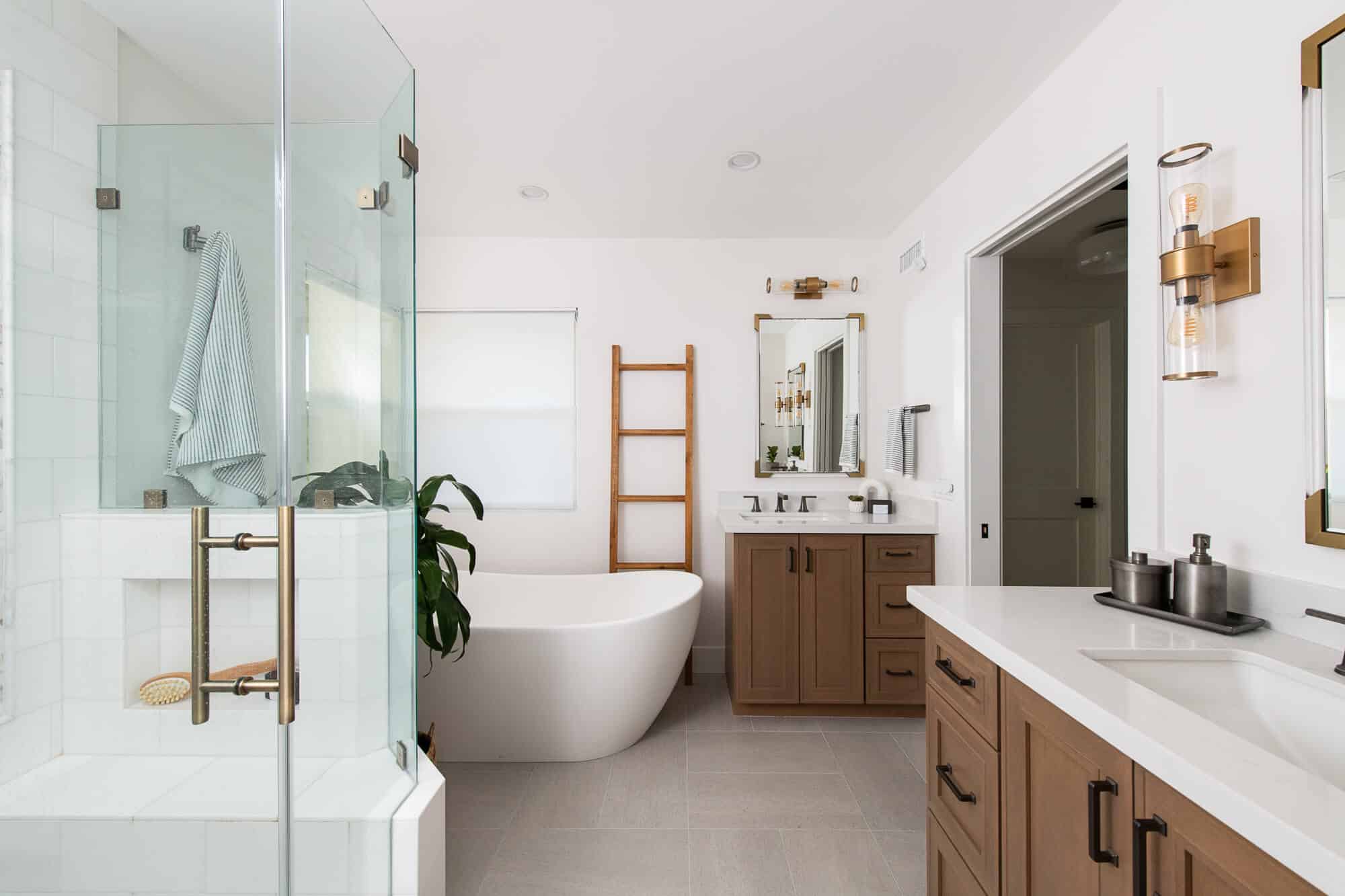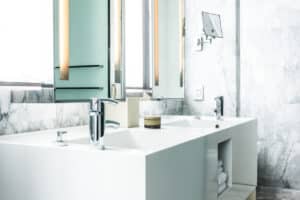Embracing Eco-Friendly Bathroom Renovations
The move towards sustainable design is more than just a trend; it’s a necessary step towards a more environmentally conscious lifestyle. In the context of bathroom renovations, adopting an eco-friendly approach opens up a world of benefits, not just for the environment, but for homeowners and businesses alike.
Why Opt for Sustainable Design?
Opting for sustainable design in bathroom renovations is a choice that pays off in multiple ways. Firstly, it significantly reduces the environmental footprint of the property. By choosing materials and technologies that minimize waste, conserve water, and reduce energy consumption, homeowners contribute to the global efforts in combating climate change.
Beyond the environmental benefits, eco-friendly bathroom renovations also result in financial savings in the long run. Water and energy-efficient fixtures can drastically reduce utility bills, making them a smart investment. Moreover, sustainable design often incorporates durable, long-lasting materials, thereby lowering maintenance and replacement costs.
Lastly, sustainable design resonates with an increasing number of consumers who are becoming more environmentally conscious. For commercial properties, an eco-friendly bathroom can be a unique selling point, appealing to customers who value sustainability.
Environmental Impact of Traditional Bathroom Renovations
Traditional bathroom renovations can have a significant environmental impact. This is due to several factors, including the use of non-renewable resources, excessive water and energy consumption, and the generation of a large amount of waste.
Building materials such as ceramic tiles, concrete, and certain types of wood contribute heavily to carbon emissions during their production process. Moreover, conventional bathroom fixtures like showers, faucets, and toilets can be highly inefficient, leading to unnecessary water and energy wastage.
Waste generation is another critical issue. Traditional renovation projects often result in large amounts of construction and demolition waste, much of which ends up in landfills. This not only contributes to the depletion of landfill space but also results in the release of greenhouse gases.
In light of these challenges, it’s clear that sustainable design is not just a desirable option but a necessary one for future-proofing our homes and businesses. In the following sections, we will delve deeper into the key elements of sustainable bathroom design, providing practical tips for implementing water and energy-saving measures, as well as incorporating sustainable materials in your next bathroom renovation project.
Key Elements of Sustainable Bathroom Design
When planning eco-friendly bathroom renovations, focusing on sustainable design elements is crucial. These elements, which include water efficiency, energy efficiency, and the use of sustainable materials, not only contribute to a greener environment but also result in long-term savings for the homeowner.
Water Efficiency
One of the key aspects of sustainable bathroom design is water efficiency. The average household can use a significant amount of water in the bathroom, from flushing the toilet to showering. Therefore, incorporating water-saving devices and fixtures into the design of the bathroom can make a substantial difference to water usage.
For instance, installing low-flow faucets and showerheads, dual-flush toilets, and smart water meters can help you monitor and reduce your water consumption. This not only conserves water but also reduces the cost of your water bills. For more in-depth information on water-saving renovation tips, stay tuned for the next section of this article.
Energy Efficiency
Energy efficiency is another critical component of sustainable bathroom design. From lighting fixtures to ventilation fans and water heaters, there are numerous ways to conserve energy in the bathroom.
Consider installing LED lights, which use significantly less energy than traditional incandescent bulbs. Also, opt for Energy Star-rated appliances and fixtures that are designed to consume less power. Insulating your hot water pipes can also prevent heat loss and improve energy efficiency. More energy-saving tips will be discussed in a later section of this article.
Sustainable Materials
Finally, using sustainable materials can greatly enhance the eco-friendliness of your bathroom renovation. This involves choosing materials that are recycled, reclaimed, or locally-sourced, which reduces the environmental impact of manufacturing and transporting new materials.
Also, selecting durable materials that are built to last reduces the need for frequent replacements, further contributing to sustainability. More detailed information on incorporating sustainable materials will be provided in a subsequent section of this article.
These key elements should be carefully considered when planning bathroom renovations to ensure they align with the principles of sustainability. By doing so, you not only create a space that’s kinder to the environment but also build a bathroom that’s cost-effective and built for longevity. Stay tuned for more in-depth discussions on water-saving, energy-saving, and sustainable material tips for your eco-friendly bathroom renovation.
Water-Saving Renovation Tips
One of the primary aspects of eco-friendly bathroom renovations is the conservation of water. Here are some sustainable design tips to help reduce the water usage in bathrooms.
Low-Flow Showerheads and Faucets
Introducing low-flow showerheads and faucets can significantly reduce the amount of water used in a bathroom. These fixtures are designed to limit the flow of water without compromising on the pressure, providing an efficient yet comfortable experience. It’s a simple change that can make a big difference to the overall water consumption in a household.
| Fixture Type | Standard Flow Rate (gpm) | Low-Flow Rate (gpm) |
|---|---|---|
| Showerhead | 2.5 | 1.5 – 2.0 |
| Faucet | 2.2 | 1.0 – 1.5 |
Efficient Toilets
Toilets are often the biggest water users in a household. By replacing older toilets with more water-efficient models, it’s possible to save thousands of gallons of water each year. Dual flush toilets, for instance, offer two flush options: one for liquid waste and one for solid waste, which uses less and more water respectively.
| Toilet Type | Water Used Per Flush (gallons) |
|---|---|
| Traditional Toilet | 3.5 – 7 |
| High-Efficiency Toilet | 1.28 |
| Dual Flush Toilet | 0.8 (liquid waste), 1.6 (solid waste) |
Greywater Recycling Systems
Greywater recycling systems capture water from showers and sinks and repurpose it for flushing toilets or irrigation. While this involves a more significant renovation, the water savings can be substantial, making it a worthwhile consideration for anyone serious about sustainable bathroom renovations.
Incorporating water-saving fixtures and systems not only contributes to a more sustainable lifestyle but also reduces water bills, proving that eco-friendly bathroom renovations can be both beneficial for the planet and cost-effective. For more tips on planning your bathroom renovation, visit our step-by-step guide on bathroom renovations: a step-by-step guide for homeowners.
Energy-Saving Renovation Tips
One of the key aspects of eco-friendly bathroom renovations involves energy efficiency. By reducing energy consumption, individuals can reduce their environmental footprint while also saving on utility costs. Here are some sustainable design tips to consider:
Energy-Efficient Lighting
Incorporating energy-efficient lighting into your bathroom renovation can significantly reduce energy usage. LED lights, for instance, use up to 80% less energy than traditional incandescent bulbs and last much longer. Installing a skylight can also provide natural light during the day, reducing the need for artificial lighting. Additionally, consider installing dimmer switches to adjust light levels and conserve energy when full brightness isn’t necessary.
Ventilation and Insulation
Proper ventilation and insulation are essential for maintaining energy efficiency in bathrooms. An energy-efficient exhaust fan can help ventilate the space, preventing the build-up of moisture and reducing the need for air conditioning.
Insulation, on the other hand, can help maintain the temperature in your bathroom, reducing the need for heating or cooling. Insulating the walls, floors, and around the hot water pipes can prevent heat loss and save energy. For more guidance, refer to our article on bathroom renovations: a step-by-step guide for homeowners.
Energy-Efficient Heating
Investing in an energy-efficient heating system can also contribute to a sustainable bathroom design. Radiant floor heating, for example, is more efficient than standard baseboard heating and usually more efficient than forced-air heating because it eliminates duct losses.
Tankless water heaters can also be a good option as they heat water directly without the need for a storage tank. When a hot water tap is turned on, cold water travels through a pipe into the unit, where it’s heated. This means no standby energy loss as with traditional storage water heater tanks.
By incorporating these energy-saving measures into your bathroom renovation, you can create a space that is both environmentally friendly and cost-effective. Remember, every step towards sustainability counts. For more tips on renovating your bathroom in an eco-friendly manner, visit our bathroom renovations section.
Incorporating Sustainable Materials
The choice of materials plays a significant role in the sustainability of your bathroom renovations. By opting for recycled, locally-sourced, and durable materials, you can minimize the environmental impact of your project while creating a stylish and eco-friendly space.
Recycled and Reclaimed Materials
Recycled or reclaimed materials are the epitome of sustainability. By utilizing these materials, you are not only reducing demand for new resources but also preventing the waste that would otherwise end up in landfills. In terms of eco-friendly bathroom renovations, there are many opportunities to incorporate recycled or reclaimed materials. These include recycled glass tiles, reclaimed wood for cabinetry, or countertops made from recycled materials. For more information on choosing materials for your renovation, visit our article on choosing the right materials for your bathroom renovation.
Locally-Sourced Materials
Using locally-sourced materials is another way to enhance the sustainability of your project. This approach reduces the environmental impact associated with transporting materials over long distances. In addition, it supports local businesses and economies. When sourcing materials, consider options like local stone for countertops or tiles, and locally-made fixtures and fittings.
Durable, Long-Lasting Materials
Investing in durable, long-lasting materials can lead to more sustainable bathrooms. Materials such as stone, porcelain, and stainless steel may have a higher upfront cost but their durability means they won’t need to be replaced frequently. This longevity not only saves money in the long term but also reduces waste, making it a smart choice for those interested in eco-friendly bathroom renovations.
By conscientiously selecting your materials with an eye toward sustainability, you contribute to a greener planet. The integration of recycled and reclaimed materials, the use of locally-sourced products, and the choice of durable, long-lasting options can all make a significant difference. For more guidance on eco-friendly bathroom renovations, explore articles such as cost-effective bathroom renovations: tips for budget planning and the ultimate checklist for commercial bathroom renovation.
Other Considerations for Eco-friendly Bathroom Renovations
Beyond water and energy efficiency, as well as the use of sustainable materials, there are other important factors to consider when planning eco-friendly bathroom renovations. These include waste reduction during renovation, the use of natural cleaning products, and the inclusion of indoor plants for improved air quality.
Waste Reduction During Renovation
One often overlooked aspect of sustainable design is reducing waste during the renovation process. This can be achieved through careful planning, repurposing existing fixtures, and responsibly disposing of construction waste.
For instance, instead of discarding old fixtures, consider how they might be updated or repurposed. An old sink might be given a new lease of life with a fresh coat of eco-friendly paint, or perhaps an old bathtub can be transformed into a unique garden feature.
For any waste that can’t be reused, ensure it is disposed of responsibly. Many materials can be recycled, while others may need to be disposed of in specific ways to minimize environmental impact. For more detailed guidance on how to manage waste during bathroom renovations, refer to our article on bathroom renovations: a step-by-step guide for homeowners.
Natural Cleaning Products
Another important consideration for eco-friendly bathroom renovations is the use of natural cleaning products. Traditional cleaning products often contain harsh chemicals that can harm both the environment and your health. Instead, opt for natural alternatives that are biodegradable and free from harmful toxins.
Furthermore, many natural cleaning products can be made at home using common household ingredients, offering a cost-effective and eco-friendly solution for maintaining your bathroom.
Indoor Plants for Improved Air Quality
Adding indoor plants to your bathroom not only enhances its aesthetic appeal but also improves air quality. Many plants are known for their air-purifying qualities, helping to remove toxins and increase oxygen levels. This provides a healthier environment for you and your family while also promoting a sense of tranquillity and connection with nature.
When choosing plants for your bathroom, consider factors such as light levels, humidity, and temperature. Some plants are particularly well-suited to bathroom environments, including ferns, spider plants, and peace lilies.
In conclusion, eco-friendly bathroom renovations involve more than just installing water and energy-efficient fixtures. By considering waste reduction, using natural cleaning products, and incorporating indoor plants, you can create a sustainable bathroom that benefits both the environment and the occupants. For more tips and advice on sustainable bathroom design, check out our comprehensive guide on eco-friendly bathroom renovations: sustainable design tips.




